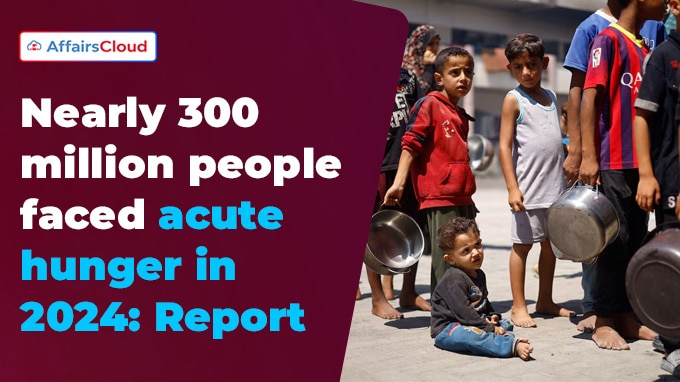 In May 2025, Rome (Italy)-based United Nations (UN)’s Food and Agriculture Organisation (FAO) released its latest report titled ‘2025 Global Report on Food Crisis (GRFC)’. The report revealed that nearly 300 million (295.3 million) people across 53 countries and territories faced acute levels of hunger in 2024, marking an increase of 13.7 million compared to 2023.
In May 2025, Rome (Italy)-based United Nations (UN)’s Food and Agriculture Organisation (FAO) released its latest report titled ‘2025 Global Report on Food Crisis (GRFC)’. The report revealed that nearly 300 million (295.3 million) people across 53 countries and territories faced acute levels of hunger in 2024, marking an increase of 13.7 million compared to 2023.
- Also, nearly 23% of the total people analysed by the report, faced acute food insecurity.
- It is the 5th consecutive year that the number of people facing high levels of acute food insecurity remained above 20% and overall 6th consecutive year of increase in these levels.
About Global Report on Food Crisis (GRFC):
i.The report is published annually by the Global Network Against Food Crisis (GNAFC) with analytical support from the Food Security Information Network (FSIN).
ii.GNAFC is a global alliance of the United Nations (UN), the European Union (EU), governmental and non-governmental agencies working together to address food crises.
iii.The 2025 Global Report on Food Crises (GRFC) analyzed acute food insecurity in 53 countries and territories for the year 2024. These regions were selected based on the severity and scale of food crises, with a focus on areas experiencing significant challenges due to conflict, economic shocks, and climate-related disasters.
- India was not among the 53 countries analyzed in the 2025 GRFC.
Key Findings:
i.As per the report, the number of people facing catastrophic food crises (IPC/CH Phase-5) more than doubled between 2023 and 2024, to reach 1.9 million , which is the highest figure on record since the GRFC started tracking in 2016. This food crisis is mainly driven by armed conflict.
- More than 90% of people facing extreme levels of hunger are in Gaza and Sudan.
- While, other countries with people experiencing catastrophic levels of acute food insecurity: the Gaza Strip, South Sudan, Haiti, and Mali.
ii.The report showed that 37.7 million children aged 6–59 months suffered from acute malnutrition in 26 countries had suffered from acute malnutrition in 2024, which includes over 10.2 million with severe acute malnutrition (SAM).
- In addition to that, 14 million children are at high risk of losing access to nutrition services due to cuts in fundings.
- It further showed that over 10.9 million pregnant and breastfeeding women in 21 countries were also acutely malnourished.
- The level of malnutrition is extremely high in countries like: the Gaza Strip, Mali, Sudan, and Yemen.
iii.Countries like: Nigeria, Sudan, Democratic Republic of the Congo (DRC), and Bangladesh, were found to have the largest numbers of people facing high levels of acute food in security, each with at least 23 million affected.
- Collectively, these 4 countries account for over 1/3rd (33%) of the global total of people in the food crisis.
iv.Globally, most forcibly displaced individuals reside in regions experiencing food crises. In 2024, an estimated 95.8 million displaced people were located across the 53 countries and territories analyzed, with approximately 75% being internally displaced.
Key Drivers of acute food insecurity and malnutrition:
i.Conflict: The report highlighted that conflict remains to be the top driver of acute food insecurity, affecting nearly 140 million people in 20 countries and territories.
ii.Forced Displacement: The report highlighted significant increase in hunger driven by forced displacement, with around 95 million forcibly displaced people which includes Internally Displaced Persons (IDPs), asylum seekers, people living in countries facing food crisis, like: Democratic Republic of the Congo(DRC), Colombia, Sudan, and Syria out of a global total of 128 million forcibly displaced people.
iii.Economic Shocks: The report has outlined inflation and currency devaluation, have played a ,major role in driving hunger in 15 countries affecting 59.4 million people, which is still around double pre-COVID 19 levels despite a modest decrease from 2023.
- Countries like: Afghanistan, South Sudan, Syrian Arab Republic, and Yemen, faced the most protracted food crisis mainly driven by economic shocks.
iv.Weather Extremes: El-Nino induced droughts and floods had pushed 18 countries into food crises affecting more than 96 million people. The report has confirmed famine in 10 regions of Sudan and 17 more on the brink.
v.Significant Cut in Global Food Aid: The report projected that global food aid is expected to decrease by 45%. This projection is based on substantial reductions by major donors and abrupt termination of funding in 2025 that has disrupted operation in countries like: Afghanistan, DRC, Congo, Ethiopia, Haiti, among others.
- This reduction in funding is expected to pose acute food insecurity risk to at least 14 million children globally, which will further push them to severe malnutrition and death.
About Food and Agriculture Organisation (FAO):
It is of the specialized agencies of the United Nations (UN), to make international efforts to combat hunger and to achieve food security for all.
Director-General (DG)- Qu Dongyu
Headquarters- Rome, Italy
Established- 1945




